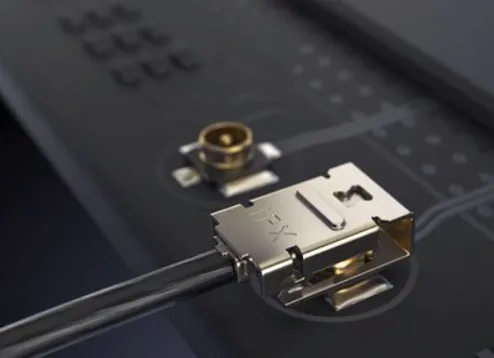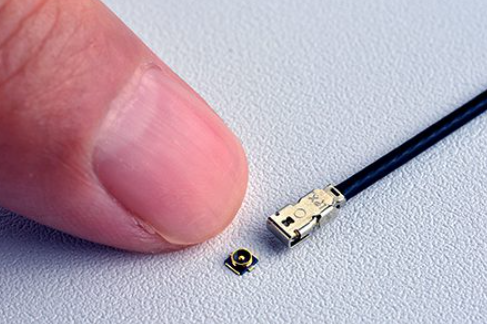What do Microminiature and Ultraminiature RF connectors entail?
RF connectors operate within the multi-megahertz radio frequency range. Technological advancements in the 2000s were driven by the need for affordable, high-data-rate wireless transceivers. This led to the development of wire-to-wire, wire-to-board, and board-to-board micro-miniature RF connectors, along with ultraminiature RF connectors, catering to the requirements of increasingly compact devices.
Travis Amrine, the global industry marketing manager at I-PEX, highlighted the evolution of RF connectors: "Since the inception of radio, RF connectors have been integral. Early radios and televisions relied on a single large transmitter and numerous lower-power receivers, resulting in connectors that were initially bulky. However, as technology progressed across frequencies and applications, these connectors underwent a significant size reduction."

I-PEX introduces the MHF I LK Micro RF coaxial connector featuring an exclusive mechanical locking innovation. (MHF is a registered trademark of I-PEX, denoting "micro high frequency.")

The I-PEX MHF 4 LK Micro RF coaxial connector showcases a proprietary mechanical locking attribute.
"As devices shrink, so do the connectors," noted Amrine. "For instance, if you own a laptop, chances are it's equipped with an MHF 4 receptacle and plug for Wi-Fi connectivity."
RF connectors are manufactured using CNC (computer numerical control) machining or, for high-volume production, through stamping and molding. MHF-style connectors, in particular, are produced in staggering quantities each year, reaching into the billions.
The diverse range of connector types within this category caters to specific application requirements such as frequency, transmission speed, market demand, robustness, size, weight, performance, and durability. David Shaff, in his analysis of RF connectors for Bishop & Associates' World RF Coax Connector Market 2023, elaborates on the array of microminiature and ultraminiature RF interfaces now available.
Miniaturized Connectors
The MCX connectors, short for Micro Coaxial, originated in the 1980s and are accessible in 50-ohm and 75-ohm variants. Similar to SMB connectors in inner contact and insulator dimensions, MCX is nearly one-third smaller and conforms to the EU standard CECC 22000. Their snap-lock mechanism enables swift and effortless mating with a full rotational capability.
MMCX connectors, denoted for Micro-Miniature Coaxial, are even smaller iterations of MCX, also adhering to the EU CECC 22000 specification. Both MCX and MMCX cover a frequency range from DC to 6 GHz.
Packaging options include individual connectors, trays, and tape-and-reel. Available are panel and PCB-mount jacks/female variants, along with both straight and 90° plugs/male suitable for semi-rigid and flexible cables.
TLMP Connectors
TLMP, an acronym for Times Locking Miniature Push-on, represents a fresh series unveiled by Times Microwave Systems, an Amphenol Company. Engineered for DC to 60 GHz applications in military, aerospace, and space domains, TLMP connectors aim to address potential shortcomings identified in SMP/SMPM connectors. These improvements encompass enhanced environmental sealing, superior EMI capabilities, improved power handling, as well as increased resistance to high vibration and shock.
Coaxial Connectors with IDC Termination
KYOCERA AVX provides a distinctive Insulation Displacement Connector (IDC) termination designed for coaxial cables, catering to 50-ohm DC to 6 GHz applications. IDC, a proven method utilized extensively for signal and power applications in cable-to-board and cable-to-cable connections, ensures rapid and dependable termination. By extending the application of IDC to coaxial-to-board assemblies, the process of microwave termination can be streamlined. Additionally, the Surface Mount Technology (SMT) housing can be positioned using automated pick-and-place techniques, facilitating lead-free reflow board assembly. Its compact form factor and robust construction render it suitable for deployment in automotive and industrial antenna applications.
QSL Connectors
Here's a rephrased version:
TE Connectivity introduces a new series with a low profile (under 0.4 inches), catering to cost-effective and robust applications like PCIe and WNIC cards. These are specifically designed for scenarios where larger connectors such as SMA or mini-BNC are impractical. The QSL series, functional across DC to 6 GHz frequencies, boasts positive 500-cycle mating, making it ideal for EIA/ECA-364-1000.01A (controlled environment) applications. These connectors are available in single and multi-position board-mount assemblies paired with RG-174 and RG-316 cables.
0.9 mm SuperMini
This connector is a compact threaded coupling solution designed for MIL/aerospace uses. Featuring a 0.9 mm interface, it theoretically supports frequencies beyond 120 GHz, yet practical production is tailored to meet customer demands, ensuring optimum performance at 65 GHz or 110 GHz. Constructed with a Teflon insulator, it closely resembles an ultra-miniature SSMA. Cable plugs accommodate 0.047 flex cables like Molex/Temp-Flex 047SC. Southwest Microwave serves as the primary supplier. Notably, in applications like space, UAV/UAS, and others requiring payload minimization, a mated pair of SMA connectors weighs around 5.0 grams, whereas a mated pair of 0.9 mm connectors weighs merely 0.56 grams (both cable plugs weighed without termination).
MOEBIUS MC-CARD and Switching Connectors: their role and characteristics...
MOEBIUS connectors form a family of microminiature, 50-ohm interconnects capable of handling up to 8 GHz, tailored for frequent mating in mobile applications. Initially introduced as "CN" connectors by Radiall, the name "Moebius" draws from the concept of the "Möbius strip," symbolizing infinite durability. These snap-on coax connectors were initially utilized for antennas, but their versatility extends to wearables, radios, mezzanine cards with end-on termination needs, and any scenario requiring a manual, single-line RF connection, prioritizing size, weight, performance, and durability.
As an alternative to MMCX connectors in various wireless and telecom applications, Moebius, introduced in 2005, aimed to supersede MMCX and MC-Card connections for wireless LAN remote antenna setups due to its exceptional durability, surpassing 25,000 mating cycles.
Nano Coax
Omnetics primarily offers coax contacts tailored for Micro-D and Nano-D connectors, typically pre-terminated with RF-178/U, suitable for operations up to approximately 1 GHz. Recognizing evolving application needs, Omnetics Corp. reengineered its coax designs to accommodate flexible .047 coax cables, empowering their 50-ohm Nano Coax to handle applications up to 20 GHz. The male/plug's center pin contact employs twist-pin construction for enhanced performance.
PCIe M2
These connectors represent the latest generation of small form factor connectors designed in compliance with the PCIe M.2 Specification Rev. 1.x, released on February 26, 2020. The M.2 form factor targets mobile adapters and serves as a transition from the PCIe Mini 3 Card and Half-Mini Card (referenced in the PCI Express Mini CEM Specification) to a notably smaller size and volume.
The M.2 form factor family facilitates expansion, contraction, and enhanced integration of functions within a single module solution. For the implementation of cabled PCI Express, the associated specification, "PCIe External Cabling Specification, Rev. 3.0," was released on September 26, 2019.
These connectors find application across various contemporary thin mobile devices, encompassing IEEE 802.11 a/b/g/n, WiMAX, ZigBee, Bluetooth, MIMO, and more. They are commonly employed in tablets, gaming consoles, smartphones, and virtually any device emphasizing a sleek profile and miniaturization.
MHF I LK Locking Connectors
One of the concerns identified by customers regarding these connectors is their susceptibility to disengagement under high-vibration and shock conditions. To address this, I-PEX introduced the MHF I LK and MHF 4L LK plug connector assemblies, specifically designed to tackle these mechanical retention challenges. These assemblies feature a patented locking mechanism ensuring secure mating via a straightforward slide-on action.
The connectors maintain compatibility with the company's standard MHF 1 and MHF 4L interfaces. The locking plug seamlessly mates with all MHF 1 and 4/4L receptacles and is available alongside a range of miniature coaxial cables varying from 0.81 to 1.80 mm OD. A detailed video showcasing the locking mechanism up close is accessible here.
Mating these connectors involves a vertical snap-down action, followed by manually sliding the lock into position, accompanied by a tactile "click" confirming the secure lock. Removing the connectors is a simple process involving a push-back and lift motion of the cover.
Ultra-compact Connectors
U.FL connectors are ultra-low profile snap-together solutions designed for miniature cable-to-board applications up to 6 GHz. Initially developed by the Hirose Electric Group, similar series such as AMC, MHF, UMCC, among others, have emerged. These connectors are typically packaged in tape and reel format. While they can be manually snapped together, special tools are required for unmating or extraction. Mating heights range from 2.0 mm to a maximum of 2.5 mm, with a slightly larger series, E.FL, featuring a height of 3.2 mm.
These connectors find widespread use in cellular phones, miniature instrumentation, GPS devices, Bluetooth technology, and various assemblies requiring small coaxial cable/connectors for relatively high-frequency applications.
In 1993, the landscape for antenna coaxial connectors was dominated by large and costly options. Sensing the imminent wave of miniaturization, Hirose pioneered a series using stamped and formed components, spearheaded by the H.FL, resulting in substantial size and cost reductions. This trend continued with the 1997 release of the U.FL connector, perfectly aligning with the demands of mobile phone antenna connections and becoming a ubiquitous choice since the mobile phone era began.
The U.FL(A) coaxial connector, measuring a mere 2 mm x 2 mm with a mated height of 2.1 mm, caters to high-frequency connectivity within a compact footprint. Delivering robust signal integrity and minimal insertion loss up to 18 GHz, its self-alignment design ensures stable and secure mating. Featuring gold-plated contacts for corrosion resistance and utilizing four ground contacts for enhanced shock and vibration resistance, the U.FL(K) Series offers enduring performance in rugged environments. With a low profile of only 2.5 mm and impressive high-frequency capabilities up to 8 GHz, the U.FL(K) Series is a go-to choice in automotive applications, including antennas, AVN (audio, video, and navigation), camera modules, and telematics. Its ultra-miniature size of 3.0 mm x 3.1 mm enables automotive designers to optimize space or incorporate additional functionalities.
On the other hand, the X.FL series by Hirose represents low-profile, ultra-miniature SMT coaxial connectors specifically tailored for six and 12 GHz WiGig applications. Offering mating heights of 0.94 or 1.2 mm, these connectors are supplied in embossed tape carrier reels, facilitating automated assembly. Board receptacles come in both straight and right-angle center contact configurations, while cable versions utilize ultra-fine, fluorinated resin insulated coaxial cables.
SW* Connectors
The subseries, ranging from larger to smaller sizes—SWD, SWF, SWG, SWH, and SWJ connectors—crafted by Murata Manufacturing Co., Ltd., comprises subminiature coax connectors, some incorporating switching functionalities. These connectors find utility in measuring microwave circuits within cellular phones and compact wireless devices like wearables.
SWD and SWF variants are utilized in PCs, while SWG and SWH cater to tablets and mobile phones. The smaller-sized SWH and SWJ versions are specifically designed for phones and wearable gadgets.
For assessing the RF circuit and antenna characteristics, these connectors can be integrated into an RF transmission line. The internally embedded mechanical switch serves to isolate the RF circuit from the ANT circuit, enabling independent measurement without any mutual effects. Murata also offers a dedicated probe for this purpose. Noteworthy specifications encompass a Voltage Standing Wave Ratio (VSWR) of 1.3 from DC to 6GHz, along with a connector durability of 50 cycles with a probe.
Design Notes:
Specifications:
The principal electrical factors revolve around the operating frequency, VSWR (Voltage Standing Wave Ratio), and insertion loss metrics. The key mechanical factors include PCB area and stack height during mating.
Applications:
These considerations apply broadly across various devices such as cell phones, laptops, Bluetooth devices, miniature instrumentation, routers, and automotive infotainment systems.
Air Conditioner Capacitor Basics: What You Need to Know
NPN VS PNP BJT Transistor: Common Knowledge
Circuit Breakers:Types and Applications
Different Types of Mixers
Flexible Sensor Complete Guide
CR2450 vs CR2032 Battery: What are the Differences?
Exploring Testing Methods: Types, Pros and Cons
CR1616 vs CR2025 Battery
What is Hartley Oscillator: Circuit, Working, and its Applications
ULN2803ADWR Transistor: Features, Applications and Datasheet










